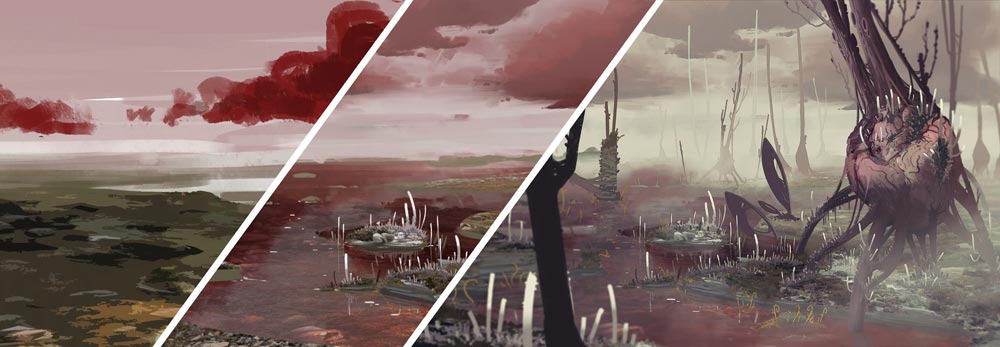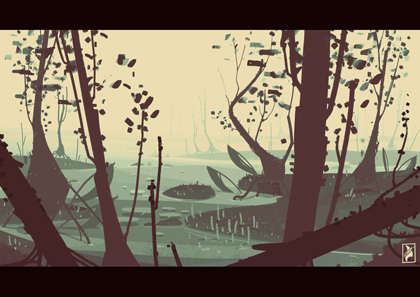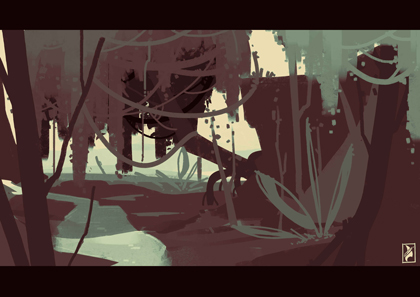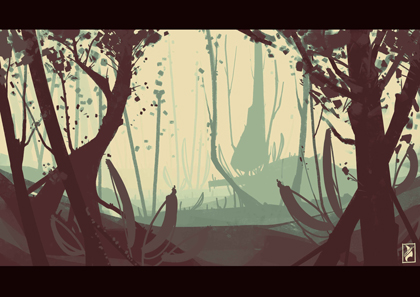
Making concept art at
Ember Glitch
Here at our studio we are convinced that both art and (game) design are exploratory in nature. The final outcome of the game is almost always the result of exploring different ways to make art and design games.
For us, concept art is a great way to quickly explore the aesthetics of characters, environments, and the setting of our games. Using this method we don't have to rely on tools and programs that involve coding or 3D modeling, which have a tendency to take longer before seeing the final picture. This is why we spend a lot of time into the concept phase of each of our projects.
Developing an art style
In our studio, the process always starts in the same way; by discussing with our team (a concept artist, two 3D artists, a technical artist, and a programmer) about what we want to communicate to the audience.
By brainstorming about the setting of the game with our team, we create a clear starting point where the whole team begins on the same page. From here we can further explore the direction we want to go towards.
The next step is finding some inspiration to guide us in the right direction. For finding inspiration we look at games, movies, photos and everything that picks our interests. For example, we look at concept art paintings from other concept artists such as H.R. Giger as inspiration for our work. We study their work and backward engineer it to discover how they are built and to see what fits well in our setting. We collect all the different kinds of inspirational sources and build multiple mood boards. The main purpose of the mood boards is to make sure that the whole team is on the same page where the project is going.
After that, we start by making the first concept paintings. The purpose of these paintings is to explore possible visualizations for the project. Because we want a unique art style, we make sure that these paintings are simple and made fast and plentiful. Doing this we end up having multiple interesting visualizations. Some of these might not suit our current project, though we keep them in our backlog for future use. This is a lesson that we learned early on. The first painted style is almost never the one we go for. When everyone is satisfied with the chosen art style, we start to iterate on that specific style to improve it and get it in our system and pipeline.




The process of design
Like with the art style, designing assets for our game always starts with communication. We start by brainstorming about the next asset that we want for our project. Every asset needs to be well thought out before it will be made in 3D and placed into the project.
For inspiration, our concept artist starts by looking in our reference folder or online for anything that fits well for the function of the current asset. This is useful to form a clear understanding of how the asset will be designed. Afterward, he starts by transforming the image from his head to an image in Photoshop.
First, several sketches are made to give a general impression of the asset. During this phase, we actively give him feedback on the sketches and afterward he proceeds to the next step.




Photobashing
The next step is making a painting which has been rendered in the art style of the game. This process can be quite a time-consuming task, thus our concept artist uses a technique called photobashing. This is a combination of painting and the usage of real photo’s to visualize the materials of an asset. This technique makes it easier to create pieces fast and with high quality. Usually, we use this technique for a semi-realistic rendering style.

The usage of concept art
For us, concept art has multiple uses it's not only for designing assets but also for marketing and as an anchor point for the development cycle. However, the main purpose of concept art is to bring the team together towards a single goal, an awesome design.
We share our concept art via social media to involve our audience with the project we're working on. Most game studios are really reluctant to share their concept early on. This is because their ideas might get stolen by other companies. Although our concepts might also get copied, we don't see it as a threat. The idea that we'll be an inspiration for other companies is a real honor. Also, by sharing our work early on forms a really powerful tool to see how the community reacts to the art style of the game.
Concept art functions a huge anchor point within the development cycle. Because the team has a benchmark of what the final quality of the project might be. Especially during long projects, it's really important to keep an eye on the final goal.
Finally, more often than not it might occur when working on a specific asset, a new idea takes shape for another new asset. So the former paintings also form as inspiration.

The connection between concept art and 3D art
Each asset painting is build up from multiple different elements. These are fully rendered images, variations of the same asset, different viewing angles etc. Certain elements are more useful for some assets and less for others, but the asset painting always consists of a rendered image. This helps the 3D artist to visualize the asset to its full potential.
After finishing the large painting, we start to make the other elements for the asset. For example, to add more information on the kind of materials the asset is made of helps the 3D artist build the asset.

To save time we use a technique called clownmasking. The created asset gets a colored mask to show which material has to be applied on which part of the asset. This is a time-saving technique because the concept artist only has to create the shape language of the asset and give it colors on the specific parts.
In our studio, concept art is one of the most important steps in the development of our games. Without our concept artist, we would be making assets in 3D without any guidelines.
